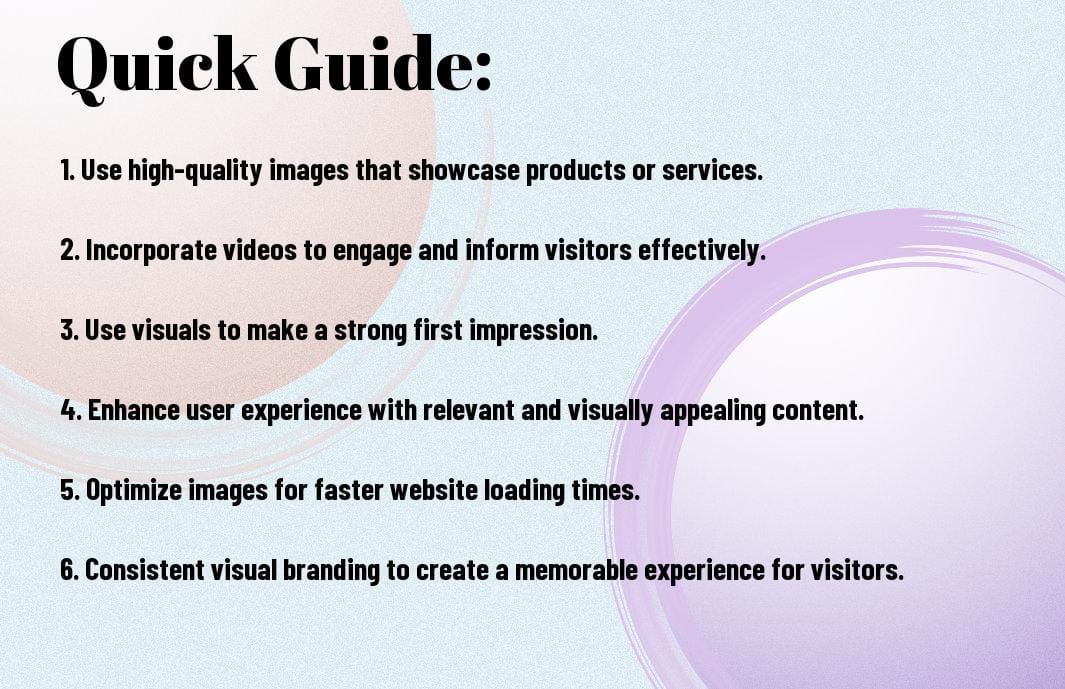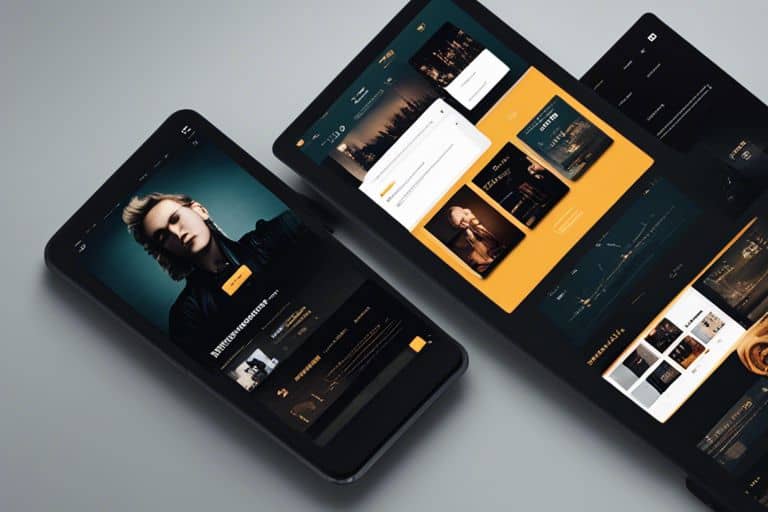The Importance Of Visuals – Incorporating High-Quality Images And Videos On Your Website
yeswebsite
14 Feb, 2024

In the matter of creating a successful website, visuals play a critical role in captivating your audience. You only have a few seconds to make a lasting impression, and high-quality images and videos can instantly grab the attention of visitors. In this guide, we will discuss the importance of incorporating top-notch visuals on your website and provide tips on how to effectively use them to enhance the overall user experience.
Key Takeaways:
- Visuals are vital for engaging visitors: High-quality images and videos can capture the attention of website visitors and encourage them to stay longer on your site.
- Enhance brand credibility: Incorporating professional visuals on your website can help establish trust with your audience and showcase the quality of your products or services.
- Improve user experience: Visuals can make your website more visually appealing and easier to navigate, leading to a better overall user experience and increased conversion rates.

Understanding the Types of Visual Content
Now, when it comes to incorporating visuals on your website, it’s vital to understand the various types of visual content available. Visuals play a crucial role in engaging visitors and conveying information effectively. Different types of imagery and video content can help you connect with your audience on a deeper level.
- Images
- Infographics
- Charts and Graphs
- Illustrations
- Videos
Perceiving the distinctions between these types of visual content can empower you to make informed decisions about what to include on your website, based on your brand identity and communication goals.
Defining Different Types of Imagery
With the constant evolution of online communication, various types of imagery have become prevalent in web design and digital marketing. Understanding the distinctions between these types of imagery is crucial for crafting a visually appealing website that resonates with your target audience.
- Photography
- Illustrations
- Icons
- Animations
- Infographics
Knowing how each type of imagery can enhance your website’s aesthetics and convey your brand message effectively is key to creating a visually cohesive online presence.
Video Content Varieties
Types of videos, such as product demos, testimonials, tutorials, and behind-the-scenes footage, offer diverse ways to engage with your audience and showcase your products or services effectively. Incorporating a mix of video content can cater to different preferences and provide valuable information in an engaging format.
Varieties of video content can help you build credibility, establish a stronger emotional connection with your audience, and boost your website’s overall user experience. By strategically integrating videos into your website, you can create a dynamic and interactive platform that captures attention and encourages visitors to explore more.
Incorporating Images and Videos on Your Website
Not only do high-quality images and videos enhance the visual appeal of your website, but they also play a crucial role in engaging your audience and conveying your brand message effectively. Incorporating compelling visuals can significantly impact how visitors perceive your website and can ultimately influence their decision to explore further or make a purchase.
Website Design and Layout Considerations
Your website design should complement the images and videos you choose to incorporate. Consider factors such as the placement of visuals, ensuring they are strategically positioned to capture the attention of your audience. The layout should be clean and uncluttered to allow the visuals to shine and not overwhelm the overall aesthetic of the site.
Furthermore, pay attention to the loading times of your images and videos. High-quality visuals are vital, but they should not compromise the speed at which your website loads. Optimize your files to maintain a balance between visual appeal and performance, ensuring a seamless user experience for all visitors.
Best Practices for Visual Storytelling
Any successful visual storytelling on your website should aim to evoke emotions, create a connection with your audience, and communicate your brand’s narrative effectively. Choose images and videos that align with your brand identity and message, maintaining consistency across all visual elements on your website.
Avoid using visuals for the sake of filling space; ensure that each image and video serves a specific purpose and contributes to the overall storytelling experience for your visitors. Engage your audience with a cohesive visual story that guides them through your website and leaves a lasting impression of your brand.
Tips for Selecting High-quality Visuals
To create a visually appealing website that attracts and engages your audience, it is crucial to incorporate high-quality images and videos. The right visuals can make a significant impact on how your brand is perceived and can help convey your message more effectively. Here are some tips to help you select the best visuals for your website:
- Choose images and videos that are relevant to your brand and message
- Opt for high-resolution visuals that are sharp and clear
- Consider the composition and framing of the visuals to ensure they are visually appealing
- Use images and videos that evoke emotions and resonate with your target audience
- Ensure that the colors and tones in the visuals align with your brand’s style and branding guidelines
Criteria for Choosing the Right Images
The key to selecting the right images for your website is to ensure that they are high-quality, relevant, and visually appealing. Images that are blurry, pixelated, or poorly composed can detract from the overall user experience and make your website appear unprofessional. When choosing images, consider the following criteria:
Make sure the images are high-resolution and optimized for the web to ensure fast loading times. Choose images that are directly related to your content and that help convey your message effectively. Pay attention to the composition, lighting, and colors in the images to ensure they are visually appealing and cohesive with your brand’s aesthetic.
Ensuring Video Clarity and Production Value
To create high-quality videos for your website, it is imperative to pay attention to video clarity and production value. Poorly produced videos can reflect poorly on your brand and may not effectively convey your message to your audience. When creating videos, consider the following tips:
Production value is crucial in ensuring that your videos are entertaining and engaging for your audience. Invest in good quality equipment, such as cameras and microphones, to ensure that your videos are clear and professional. Pay attention to lighting and sound quality to enhance the overall viewing experience for your audience.
Step-by-step Guide to Adding Visuals to Your Website
Many studies have shown that incorporating high-quality images and videos on your website can significantly improve user engagement and retention. In this step-by-step guide, we will walk you through the process of adding visuals to your website to enhance the overall user experience.
| Step 1: Planning Your Visual Content Strategy | Step 2: Technical Aspects of Uploading Media |
| Define your target audience | Optimize images and videos for web |
| Research trending visual content | Choose the right file formats |
| Create a content calendar | Implement responsive design |
Planning Your Visual Content Strategy
For a successful visual content strategy, it is crucial to first define your target audience and understand their preferences. Research trending visuals in your industry and create a content calendar to ensure consistency in posting. By planning ahead, you can better align your visual content with the overall messaging of your website.
Additionally, consider the tone and style of your visuals to ensure they resonate with your target audience. Whether you choose to use professional photos, user-generated content, or stock images, the key is to maintain visual consistency and relevance to enhance brand identity and storytelling.
Technical Aspects of Uploading Media
An important aspect of adding visuals to your website is optimizing them for web use. This includes resizing images and compressing videos to ensure fast loading times and minimal impact on site performance. Choose the right file formats such as JPEG for images and MP4 for videos to maintain high quality while minimizing file size.
Website performance is crucial for user experience and SEO, so implementing responsive design for your visuals is crucial. Make sure your images and videos are responsive and can adapt to different screen sizes to provide a seamless viewing experience across devices.
Factors Influencing the Effectiveness of Visuals
Keep in mind that the effectiveness of visuals on your website can be influenced by various factors. Understanding these factors can help you make informed decisions on how to incorporate high-quality images and videos to enhance your online presence.
- Quality of the visuals
- Relevance to your content
- Consistency in style
- Placement on the website
Knowing how these factors play a role in the impact of visuals can significantly improve the overall user experience on your website.
Understanding the Role of Context and Relevance
Influencing the effectiveness of visuals, context and relevance are key aspects to consider. The images and videos you choose should align with your brand’s message and the content they are paired with. Irrelevant visuals can confuse visitors and dilute the impact you intend to make. By ensuring that your visuals complement your text and overall website design, you can create a cohesive and engaging user experience.
Impact of Loading Times and SEO
Any delay in the loading times of your visuals can have a negative impact on user experience. Slow-loading images and videos can lead to increased bounce rates as visitors become impatient and navigate away from your site. Additionally, optimizing your visual content for SEO can help improve your website’s visibility in search engine results, potentially driving more traffic to your site.
With search engines increasingly prioritizing websites with fast loading times and high-quality visuals, investing in optimizing your images and videos can have a significant impact on your online presence and overall success.
Pros and Cons of Using Visuals on Your Website
All websites can benefit from incorporating high-quality images and videos, but it is important to weigh the pros and cons of using visuals on your website. Here, we will explore the advantages and disadvantages of using visual content to enhance your online presence.
| Pros | Cons |
| Enhances user engagement | Slow loading times |
| Increases brand visibility | Accessibility issues |
| Conveys information quickly | Copyright concerns |
| Boosts SEO | Cluttered design |
| Establishes emotional connection | Overwhelming visual elements |
The Benefits of Engaging Visual Content
The role of visual content in content marketing is crucial for capturing the attention of your audience. Incorporating compelling images and videos can significantly enhance your website’s appeal and drive more traffic. To learn more about this topic, you can check out The role of visual content in content marketing & how to ….
Visual content can effectively convey your brand message and values, making your website more memorable to visitors. Additionally, engaging visual elements can lead to higher retention rates and increased sharing on social media platforms, boosting your online presence.
Potential Drawbacks and How to Mitigate Them
Potential drawbacks of using visuals on your website include slow loading times, accessibility issues, copyright concerns, and a cluttered design. It is important to optimize your images and videos for web use, ensure compatibility with assistive technologies, obtain proper permissions for visual assets, and maintain a clean and organized layout to mitigate these issues.
To prevent overwhelming visual elements, focus on quality over quantity and maintain a balance between text and visuals on your website. By addressing these potential drawbacks proactively, you can effectively leverage the power of visual content to enhance your online platform and engage your audience.
Advanced Techniques in Visual Optimization
Your website’s visual content plays a crucial role in attracting and engaging your audience. By incorporating advanced techniques in visual optimization, you can enhance the user experience and improve your website’s performance. In this chapter, we will explore some key strategies to take your visual content to the next level.
- Responsive Design for Multiple Devices
| Visual | Details |
| Adaptability | Ensure your images and videos are responsive and adjust smoothly across various devices. |
| Optimized Loading | Compress your visual assets to maintain quality while minimizing load times on mobile devices. |
Responsive Design for Multiple Devices
Visual content must be optimized for responsiveness across different screen sizes, including desktops, laptops, tablets, and smartphones. Implementing responsive design ensures that your images and videos adapt seamlessly to the device being used, providing a consistent and user-friendly experience.
By optimizing your visual content for multiple devices, you can reach a broader audience and enhance engagement levels. Consider factors such as loading times, image resolution, and layout to ensure a cohesive visual experience across all devices.
- Using Analytics to Measure Visual Content Performance
| Design | Insights |
| Data Tracking | Utilize analytics tools to track the performance of your visual content and make data-driven decisions. |
| User Engagement | Measure metrics like click-through rates and time spent on visual elements to gauge audience interaction. |
Using Analytics to Measure Visual Content Performance
Designing visually appealing content is necessary, but understanding how users engage with it is equally important. By leveraging analytics tools, you can gain valuable insights into the performance of your images and videos. Analyze data such as views, clicks, and conversions to determine what visual content resonates most with your audience.
A comprehensive analysis of visual content performance allows you to make informed decisions on future visual strategies. By continuously monitoring and optimizing your visual assets based on analytics data, you can enhance user experience, drive conversions, and ultimately achieve your website goals.
Final Words
Hence, it is important for businesses to understand the importance of incorporating high-quality images and videos on their website. Visuals play a crucial role in capturing the attention of visitors, conveying brand messages, and increasing engagement. By utilizing visually appealing content, companies can enhance their online presence, establish credibility, and leave a lasting impression on their audience.
Investing in professional imagery and videos is not just a trend but a necessary step in today’s digital world. By incorporating these elements into their website, businesses can differentiate themselves from competitors, improve user experience, and ultimately drive conversions. The impact of visuals should not be underestimated, as they have the power to significantly influence how customers perceive a brand and its products or services. Therefore, businesses should prioritize the use of high-quality images and videos to create a visually compelling online presence.
FAQ
Q: Why are visuals important for a website?
A: Visuals are crucial for capturing and maintaining the attention of website visitors. High-quality images and videos help to make a website more engaging, memorable, and visually appealing.
Q: How do high-quality images and videos enhance user experience?
A: High-quality visuals help to enhance user experience by providing a more immersive and interactive browsing experience. They can help communicate information more effectively and create a lasting impact on visitors.
Q: What impact do visuals have on brand perception?
A: Incorporating high-quality images and videos on a website can significantly impact brand perception. It helps to convey professionalism, credibility, and aesthetic appeal, which can enhance the overall image of a brand.
Q: How can visuals improve website conversion rates?
A: Compelling visuals have the power to attract and engage visitors, leading to increased time spent on the website and higher chances of conversion. Well-chosen images and videos can influence purchasing decisions and drive action from users.
Q: What are some best practices for incorporating visuals on a website?
A: When incorporating visuals on a website, it’s important to use high-quality images and videos that are relevant to the content. Optimize images for web loading speed, ensure they are visually appealing, and maintain consistency in style to create a cohesive look and feel. Additionally, consider the accessibility of visuals for all users, including those with disabilities.
Continue reading
Purely you






Leave a Reply